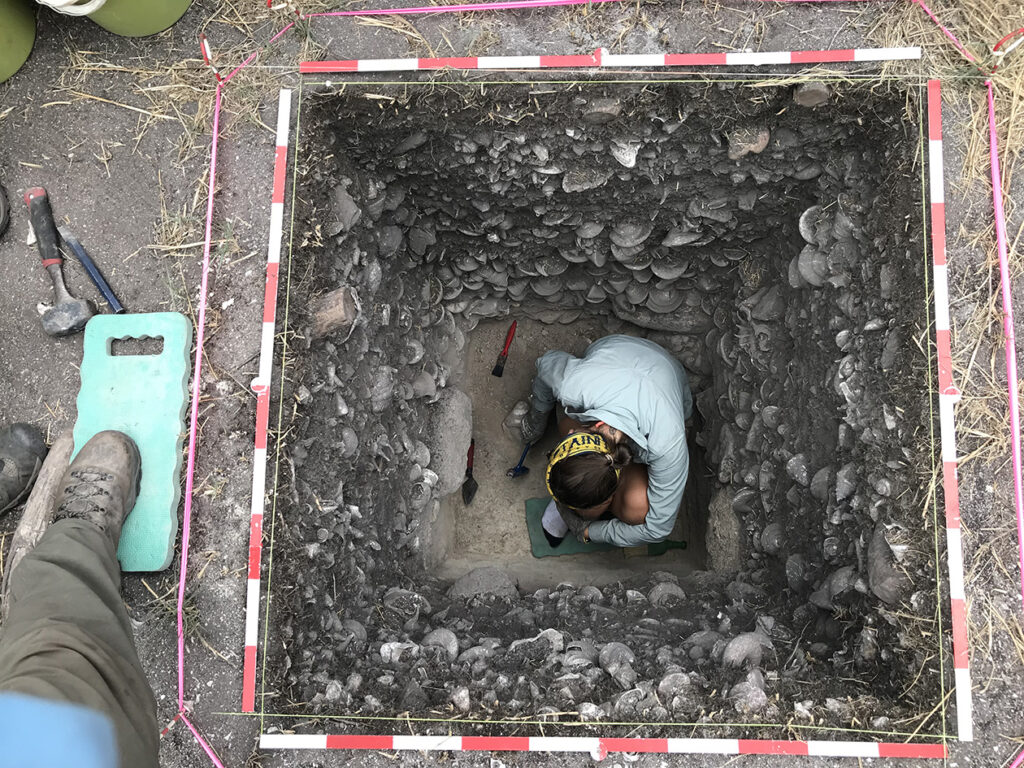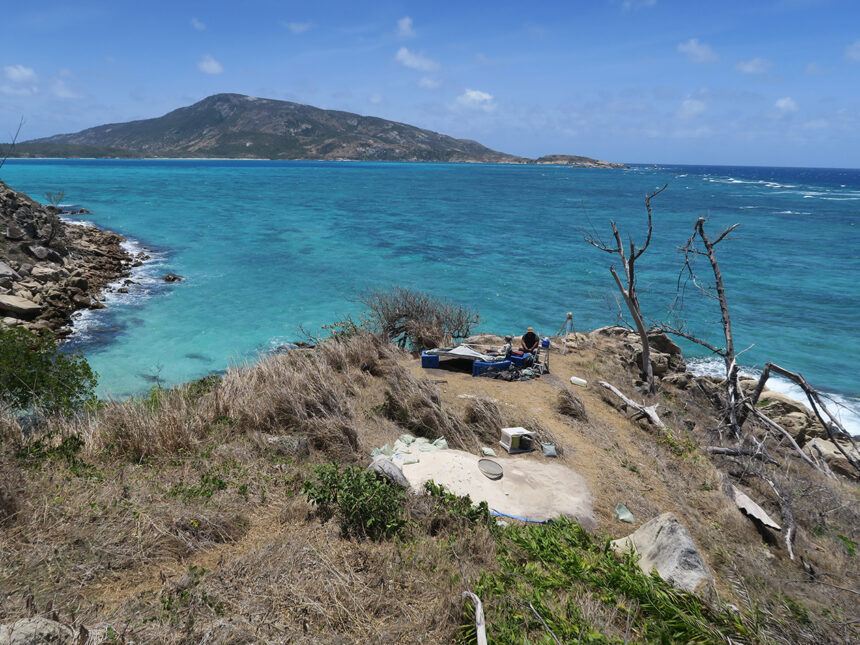

In a paper published in Quaternary Science Reviews, Traditional Owners and researchers report on the oldest securely dated pottery discovered in Australia, located at Jiigurru (Lizard Island Group) on the Great Barrier Reef in northeastern Australia.
This significant finding challenges previous notions that Aboriginal Australian communities were unaware of pottery manufacture before European settlement, instead suggesting a rich history of long-distance cultural exchanges and technological innovation long before British arrival.
The ceramics were discovered in an archaeological excavation on Jiigurru conducted by the Australian Research Council Centre of Excellence for Australian Biodiversity and Heritage (CABAH) in partnership with the Dingaal and Ngurrumungu Aboriginal communities for which Jiigurru holds significant cultural importance, serving historically as a site for ceremony, initiation, gathering, and knowledge transmission.
Archaeologists excavated the 2.4-metre-deep midden over a two-year period to discover evidence of occupation, such as the remains of shellfish and fish collected and eaten by people on the island, which are more than 6000 years old. This makes Jiigurru the earliest known offshore island occupied on the northern Great Barrier Reef. Less than a metre below the surface, the team found dozens of pottery sherds dating between 2000 and 3000 years old—the oldest pottery ever discovered in Australia.
Geological analysis of the ceramics indicates the pottery was locally produced using clays and tempers sourced from Jiigurru. The age of the pottery overlaps with a period when the Lapita people of southern Papua New Guinea were known to have produced pottery.
Dingaal clan member and Walmbaar Aboriginal Corporation Chairperson Kenneth McLean said: “Working in collaboration with archaeologists and Traditional Owners and working on Country is something that's never been done before for my people, where we work together on Country, sharing each other's story on Country, and not only sharing this story from our people, the Old People, and from the archaeology side, scientifically, which is a good outcome that we can see. We can look after the Country together.”
Ngurrumungu Elder Brian Cobus said: “Every bit of knowledge we gain helps us tell the story of Country. Research projects like this help us all to understand Country better and help us to understand how to look after Country.”
CABAH Chief Investigator Distinguished Professor Sean Ulm from James Cook University said the discovery reveals that the Aboriginal communities in North Queensland had connections with the pottery-making communities of New Guinea.
“The discovery gives us insights into the sophisticated maritime capabilities of First Nations communities in this region, and these objects are crucial in understanding the cultural exchanges that occurred on Jiigurru thousands of years ago,” Professor Ulm explained.
“We think that the ancestors of contemporary Traditional Owners were engaged in a very widespread trading system. So they traded technology, goods and ideas, knew how to make pottery, and made it locally.”
CABAH Chief Investigator Professor Ian McNiven from Monash University said the evidence points to a history of deep connections across the Coral Sea, facilitated by advanced canoe voyaging technology and open-sea navigation skills, contradicting the outdated notion of Indigenous isolation.
“These findings not only open a new chapter in Australian, Melanesian, and Pacific archaeology but also challenge colonialist stereotypes by highlighting the complexity and innovation of Aboriginal communities,” Professor McNiven said.
“The discovery adds a new layer to our understanding of Jiigurru and Indigenous Australians’ role in the broader network of maritime exchange and cultural interaction across the Coral Sea.”
According to Professor McNiven, Jiigurru marks the southern boundary of ancient international maritime networks that linked eastern north Queensland, southern New Guinea and the Torres Strait, forming the Coral Sea Cultural Interaction Sphere.
“These networks facilitated the exchange of objects and ideas between Australian and New Guinean coastal communities over the past 3000 years. While some objects, like cone-shell body adornments and bamboo smoking pipes, indicate widespread sharing of culture and ideas, others, such as pottery, also suggest the sharing of technology.”
The paper will be available from 6:00 am AEST Wednesday 10 April 2024.
https://doi.org/10.1016/j.quascirev.2024.108624
Additional notes
CABAH’s research, undertaken in partnership with the Dingaal and Ngurrumungu Aboriginal communities, formed the basis of the Queensland Museum exhibition Connections across the Coral Sea: A story of movement. Read more here, explore a virtual tour of the exhibition here, and browse objects from the exhibition here.
This research was conducted by the Australian Research Council Centre of Excellence for Australian Biodiversity and Heritage (project number CE170100015) with the Dingaal and Ngurrumungu Aboriginal communities as partners. The research team comprises 40 researchers from 26 institutions and is led by CABAH Chief Investigators Distinguished Professor Sean Ulm (James Cook University) and Professor Ian McNiven (Monash University).
Key Facts:
Archaeologists excavated a 2.4-metre-deep midden on Jiigurru over a two-year period to discover evidence of occupation more than 6000 years old and pottery sherds dating between 2000 and 3000 years old.
About us:
The Australian Research Council Centre of Excellence for Australian Biodiversity and Heritage (CABAH) is enhancing our understanding of Australia's unique cultural and natural history over the past 130,000 years. Working with our Indigenous partners, we explore diverse locations, from remote tropical islands to ancient windswept lunettes, boggy swamps, and the arid interior to tell a culturally inclusive and globally significant history of our region. We call this ‘our epic story’, and our intent is for the cultural and scientific narratives developed through our transdisciplinary research to guide our efforts in preserving and managing Australia's biodiversity and cultural heritage for the present and future.
Contact details:
Distinguished Professor Sean Ulm, CABAH Chief Investigator, James Cook University
sean.ulm@jcu.edu.au | +61 417 792 191
Professor Ian McNiven, CABAH Chief Investigator, Monash University
Ian.McNiven@monash.edu | +61 447 754 578
Kenneth McLean, Dingaal clan member and Walmbaar Aboriginal Corporation Chairperson
+61 497 336 615
Jacqueline Wales
CABAH Communications and Media Manager
jwales@uow.edu.au

